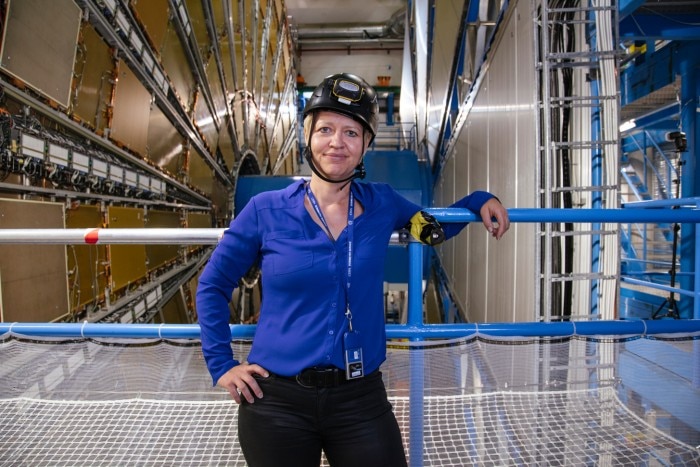MENU
CZ | CZK
CZ | CZK
No results found
Search Suggestions

In Search of the Big Bang
Explore Life Science
- Off the Bench
- Bright Minds
What holds our world together at its very core? This question engages particle physicist Beate Heinemann at the German Electron Synchrotron in Hamburg. Also: why scientific success takes luck.
You study the Higgs boson and search for dark matter. How do you explain to your parents what you do on a daily basis?
Beate Heinemann: We want to understand the fundamental laws of nature which determine the evolution of our universe as well as its future. In the subatomic realm, there are many phenomena that we can describe very well but not yet fully explain – for example, why there is more matter than anti-matter.
What is essential about this question?
Today’s universe consists almost exclusively of matter. According to the theory, however, the Big Bang should have generated equal amounts of matter and anti-matter. The problem: when matter and anti-matter collide, they extinguish each other – and become light. Therefore, a physical phenomenon must have caused matter to be left over and anti-matter to disappear. Otherwise, none of us would be here. It is therefore literally an existential question that we cannot answer based on today’s theory.
Your research takes you back to the beginning of the universe.
During the experiments that we conduct – for example, in the particle accelerator Large Hadron Collider (LHC) at CERN – we generate very high energies similar to those that existed following the Big Bang. We hope to come across hitherto unknown laws of nature which may be able to explain the asymmetry between matter and anti-matter. These experiments also serve as microscopes with which we can study the subatomic universe – i.e., particles that are a billionth the size of an atom. And the higher the energy the smaller the particles we can detect.
As the first woman since the founding of German Electron Synchrotron (DESY), you have held the position of Director of Particle Physics since February 2022. What would you like to promote and advance in this role in the future?
Particle physics at DESY is already very well positioned. We are heavily involved with international projects at CERN and in Japan, where we play a decisive role. We are currently working on new trackers which are of critical importance to the experiments conducted at the LHC. In collaboration with international as well as German universities, we also carry out local experiments: for example, we have built a program to look for what are known as axions. These are hypothetical particles which, according to the theory, zip all around and through us. Axions are considered hot contenders for particles that make up dark matter. This is matter that does not interact with light – meaning that it is ultimately invisible.
Of which there is considerably more than there is normal matter.
According to our current understanding, there is almost six times more dark matter than there is normal matter – but we do not know what it actually is and what it consists of. This means that we have currently no idea about a large part of our universe. So far, dark matter only gives itself away through its gravity. And it is exactly this gravity that is impossible to study in particle accelerators because in comparison with other natural forces it is much too weak. We have now planned three experiments for the purpose of detecting these axions and, along with these, ideally also the dark matter.
In one of these experiments, you attempt to shoot light through a wall.
The idea behind it is this: inside a strong magnetic field, the axions can transform into light particles, also known as photons, and vice versa. We utilize a high-intensity laser – a lot of light – and shoot this through a strong magnetic field, onto a wall. And if light particles transform into axions, these will be able to pass through the wall due to their low interaction with matter. In the magnetic field on the other side of the wall, they can then transform back into photons. If, in fact, light shines through the wall, this would constitute proof that there at least are axion-like particles. Starting this summer, the experiment is scheduled to deliver the first results.
Nobel laureate in physics Leon Lederman identified luck as one of the most important ingredients of scientific success.
As a female researcher, one must specialize. And this also includes deciding in favor of a research subject, as well as a path. One must be lucky when it comes to searching for the right thing in the right place – after all, we don’t know whether axions actually exist or not. Many Nobel Prize discoveries in particle physics and other areas were based on luck. Even the mechanism of action of the mRNA molecule, on which the vaccines against the coronavirus are based, was discovered by chance during the course of basic research. For this reason, research for the sake of research is at least as important as applied science. It’s the only way to find that which you were not looking for.
When it comes to science, what has been your luckiest moment?
On the one hand, it was certainly the discovery of the Higgs boson. The fact that we were able to detect a particle through experimental means which had been suspected to exist for the past 50 years was, and still is, beyond belief to me. On the other hand: if, after many all-nighters, these complex, highly technical detectors that we have been developing and building for more than a decade, actually work – that can also be considered tremendous luck.
Read more
Read less
